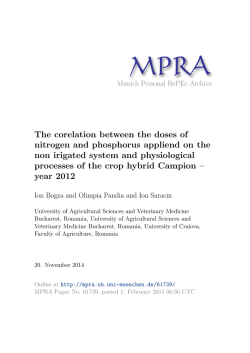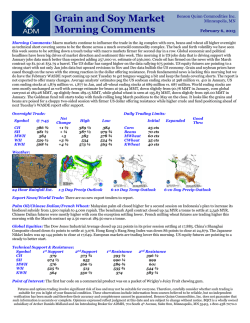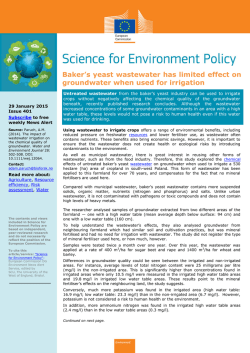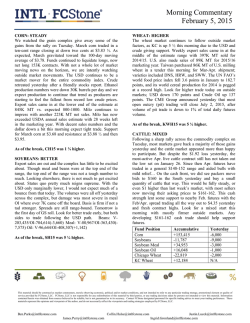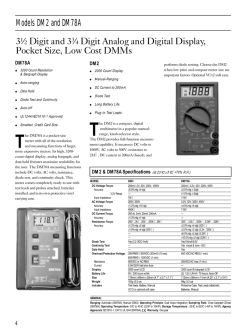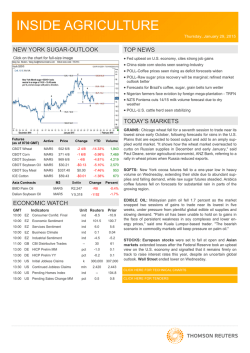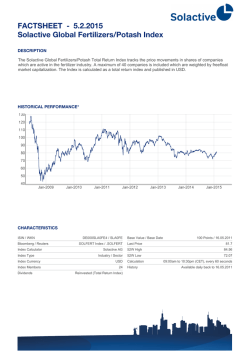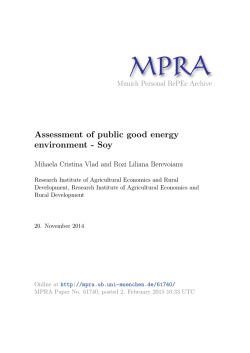
Download (425kB) - Munich Personal RePEc Archive
M PRA Munich Personal RePEc Archive Physiological proprieties from corn influenced by the differentiate application of nitrogen and phosphorus Ion Bogza and Olimpia Pandia and Ion Saracin University of Agricultural Sciences and Veterinary Medicine Bucharest, Romania, University of Agricultural Sciences and Veterinary Medicine Bucharest, Romania, University of Craiova, Faculty of Agriculture, Romania 20. November 2014 Online at http://mpra.ub.uni-muenchen.de/61738/ MPRA Paper No. 61738, posted 1. February 2015 06:34 UTC PHYSIOLOGICAL PROPRIETIES FROM CORN INFLUENCED BY THE DIFFERENTIATE APPLICATION OF NITROGEN AND PHOSPHORUS ION BOZGĂ1, OLIMPIA PANDIA1, ION SĂRĂCIN2 Abstract: The paper enumerates several physiological processes that take place at the Campion corn hybrid and the interaction between the hybrid in the irrigated and un-irrigated culture, as well as the appliance of NP fertilizers. To obtain performances at this type of corn culture, soil analyses were made before the establishment of experimental parcels and it was aimed the moment when the corn plants had already formed eight leaves to emphasize the results better. The determinations and the laboratory analyses emphasizes the most important physiological processes from plant life, where the water and fertilizer dosages had a crucial role in obtain of positive results. Key words: physiological processes, respiration, transpiration, carotene, hybrid INTRODUCTION In our country, the maize crop (culture) occupies an important area of the arable land and it represents one of the main cereal crops because of its importance in nourishment, feeding the animals and in industry. The demographic growth of the population as well as the animal effectives imposed an extension of crop areas and a growth of production/ area; these two aspects were possible by an intensification of maize crop by using chemical fertilizers and irrigation systems. Because maize culture is the most extended culture in the world, not only in our country, research into discovering new productive and qualitative hybrids have been performed, for human beings, animals and also industry, and different properties and processes were had in view. Because corn can adapt at almost all types of soil in Romania, numerous varieties and hybrids were created, thus it occupies the largest culture surface from Romania. The corn culture has a vast area of spreading and in the southern and western parts can be made big productions of corn, even for satisfying the needs necessary of national economy. Because in the human nutrition, corn grains are consumed in different forms, it is important to have healthier corn cultures, so that the products that derives from them to be beneficial for our organisms. In the human nutrition only corn grains are considered and they are an important aliment consumed in various ways, specific to each nation. The grains are used as they are, as boiled or baked corn (very indicated for this type is the sweet corn). Sweet corn grains detached from the cob in milk maturation are used boiled or canned like grained peas. MATERIAL AND METHOD The study was performed using an Campion maize hybrid, when the 8 full-grown leaves became visible and this hybrid was cultivated in the north-western part of Olt District, at Grădinari, on chernozem, and both irrigated and non-irrigated systems were a used, after a precursory wheat culture in 2012, and physiological analysis were performed in order to point out the changes of the chemical composition of plants when applying different dosage of NP. Analysis were performed by using variants disposed in four repetitions having as an example one row graduated multi-staged plots of land method. The sowed area of the variant is of 22.4 m², and its density is of 50,000 plants/hectare. Analyses of soil were effectuated at 0-25 cm and 23-34 cm. depth. 1 Conf.univ.dr. Ion Bozgă: University of Agricultural Sciences and Veterinary Medicine Bucharest, Romania, e-mail: [email protected], 1Sl.univ.dr.ing. Olimpia Pandia: e-mail: [email protected] 2 Prof.univ.dr.ing. Ion Sărăcin: University of Craiova, Faculty of Agriculture, Romania, e-mail: [email protected] Table 1 Chemical properties of the argic chernosiomus from the Grădinari-Olt Genetic level Depth(cm) pH value (H2O) S.B. m.e/100g S.H. m.e Humus % N total % P p.p.m. K p.p.m. ApI Ap1 Ap2 Ap3 ApII Ap1 Ap2 Ap3 0-25 0-25 0-25 0-25 25-34 25-34 25-34 25-34 7,02 7,03 7,01 7,02 7,19 7,16 7,18 7,19 24,37 24,39 24,36 24,38 26,85 26,84 26,85 26,86 3,43 3,47 3,45 3,43 2,32 2,34 2,31 2,33 2,78 2,77 2,77 2,76 29,18 29,19 29,18 29,17 0,141 0,143 0,142 0,141 0,133 0,135 0,133 0,134 22,7 22,9 22,7 22,8 28,2 28,2 28,4 28,3 166,8 166,5 166,7 166,5 172,9 172,7 172,8 172,8 Field research method Establishing an optimum fertilization system which positive influences the quantity and the quality of the culture and which implies an improving of the soil fertility potential represents an important way of increasing the economic efficiency. The influence of chemical fertilizers upon the maize culture is related to physiological processes which take place at a plant level in certain moments of its growth. The experiment has in view two important factors: Factor A: irrigating system B1 – irrigated B2 – non-irrigated Factor B: applying the dosage of fertilizer Within the experimental filed an important moment was followed, respective the 8 fullgrown leaves phase, and lab tests were kept in order to perform physiological determinations. Table 2 Influence of the nitrogen and phospoorus on some physiological processes of the crop hybrid Campion - 20 june non irrigated system 2012 Variant Photosynt hesis mgCO/cm 2 N0P0 N60P40 N80P60 N100P80 N120P100 228,6 253,5 256,6 260,9 253,5 Respirati on mgCO2/ 100g m.v. Absorptio n capacity g /apă Suction force atm 183,6 189,8 201,4 210,5 206,6 5,89 5,94 5,87 6,03 5,95 4,1 4,2 4,13 4,13 417 Chlorophyll A mg/dm2 0,363 0,369 0,368 0,372 0,377 Chlorophyll pigments Chlorophyll Caro B ten mg/dm2 mg/dm2 0,168 0,173 0,175 0174 0,172 0,199 0,21 0,205 0,202 0,207 Total mg/dm2 0,728 0,75 0,746 0,746 0,753 Table 3 Influence of the nitrogen and phospoorus on some physiological processes of the crop hybrid Campion - 20 June irrigated system 2012 Chlorophyll pigments Caro ten mg/dm2 Variant Photosy nthesis mgCO/c m2 Respiratio n mgCO2/ 100g m.v. Absorptio n capacity g /apă Suction force atm Chlorophyll A mg/dm2 Chlorophyll B mg/dm2 N 0P 0 N60P40 N80P60 N100P80 N120P100 239,8 262,5 268,4 270,6 276,9 186,6 192,4 205,5 215,8 220,5 6,02 6,11 6,22 6,16 6,24 4,1 4,19 4,3 4,3 4,27 0,376 0,39 0,387 0,389 0,378 0,177 0,179 0,182 0,188 0,186 0,212 0,219 0,23 0,228 0,225 Total mg/dm2 0,763 0,777 0,788 0,803 0,789 After lab determinations of physiological processes which took place in the case of this hybrid in two different systems and after applying different doses of fertilizers, the results where also graphically represented. Figure.1 Influence of the nitrogen and phosphorus doses on some physiological processes ot the crop hybrid Campion- 20 june year 2012 The chlorophyll pigments represented by ‘a’ and ‘b’ chlorophyll and carotene are very influenced by irrigated variants compared to non-irrigated ones (figure 1.) An increase of the content of chlorophyll ‘a’ in the case of the irrigated system is noticeable, no matter what dose of fertilizer was applied, significant values are observed when applying N100P80 and N120P100. Chlorophyll ‘b’ has values that have a weak fluctuation no matter what dose of fertilizers was applied, an import factor in this case is the irrigating the area which led to a significant increase of this assimilative pigment. The content of carotene has significant values towards the control, compared to variants where fertilizers were applied. Irrigating, when applying N100P80 and N120P100, led to an important increase of this pigment. Combined irrigation and applying moderate dose of fertilizers (N100P80) led to a maximum carotene quantity. Figure.2 Influence of the nitrogen and phosphorus doses on some physiological processes ot the crop hybrid Campion- 20 june year 2012 The evolution of photosynthesis (picture 2 and 3) expressed by mg CO/dm² that was determined in the first moment, that is the 8 full-grown leaves, has an important increase when comparing the non-irrigated and the irrigated variants, and also within the same variant. Thus, a 20% increase of the photosynthesis intensity towards the control in the case of irrigated variant towards the non-irrigated control is noticeable. The optimum dose, as it is noticed in figure 2, was recorded in the case of the irrigated variant, when using N120P100, compared to the non-irrigated variant where better results were obtained when applying a dose of N100P80. Regarding the respiration process, expressed as mg CO2/100 g.m.v., significant values on June, 20 are ascertain within the irrigated system as well as the non-irrigated system as well, the quantity of eliminated CO2 being significant in the case of the studied variant. The capacity of absorption, g/H2O, has minimum values in the case of non-irrigated variants, excepting the N100P80 variant which has the highest value, that is 6.02 g/H2O. Within the irrigated variants, the difference is important and it is static assured once the content of fertilizer in the case of N120P100 variant increases. The suction force (figure 2d), expressed as atmospheres, has a tendency of slow increase in the case of the first non-irrigated variants, after which it starts to increase and it reaches from 4 to 4.16 atmospheres. In the case of variants where irrigation was applied, the most evident suction force was registered when applying a N120P100 dose. CONCLUSIONS The combined influence between hybrid and culture technology (irrigation and applying the right dose of fertilizers) determines modifications of the main physiological processes which lead to obtaining maximum production when rationally applying dose of fertilizers. The studied hybrid acted differently from the culture technology point of view, the registered values from the physiological point of view were different, each of them using the right quantity of fertilizer. The effects of simultaneously applying variable doses of fertilizers and irrigation were studied and its effect upon the main physiological processes which depend on them. All analyzed physiological processes lead us to the conclusion that the Campion hybrid has a high physiologic and biochemical potential, and the acquired information situates it among the most productive hybrids that have been studied. The combined influence of culture system (irrigated non-irrigated) as well as the applied doses of fertilizers determined, from the quantitative point of view, remarkable differences in the case of all qualitative features of the Campion hybrid. We highly recommend Campion hybrid for production, when using an irrigated system and applying a maximum dose of N120P100 and N100P80 for an economic efficiency. BIBLIOGRAPHY 1. Abu-Awwad A. M. (1999). Irrigation water management for efficient water use in mulched onion. Journal of Agronomy and Crop Science vol. 183. 2. Goian M. F. Sala, Adina Berbecea, Isidora Radulov, C. Gherban . (2000). The effect of mineral fertilizers upon the bean production of maize, on cambic chernozem within the Timisoara Didactic Reasearch Station, between 1997 and 1999. Scientific research U.S.A.M.V. Timisoara, Agriculture Category. volume XXXII, part I. Agroprint Publishing House. Timisoara. 3. Hera C. (1972). The influence of fertilizers upon certain maize hybrids sowed on different types of soils in Romania. An. ICCPT. Fundulea XXXVII. 4. Marghidanu, N. et al. (1985). Economia mecanizării agriculturii. Editura Ceres. Bucureşti. 5. Mărghitaş Marilena, M. Rusu. (2003). Utilizarea îngrăşămintelor în agricultură. Ed. AcademicPres. ClujNapoca. 6. Oancea, I. (1998). Tratat de tehnologii agricole. Editura Tehnică. Bucureşti. 7. Olimpia Pandia. (2006) Fertilizer doses, different methods applied for establishing the quality of two hybrids Danubiu and Minerva. Scientific research I.N.M.A.T.E.H.I. Bucharest. 8. Sărăcin, I. (2005). Energetic Base for Agriculture. Transmissions. Unversitaria Publishing House. Craiova. 9. Sima E. (2002). Ecological Agriculture and Changing Perception in the Case of Quantity and Quality. The Information and Economic Reference Material Center. Bucharest.
© Copyright 2025
